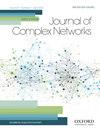A fast algorithm to approximate the spectral density of locally tree-like networks with assortativity
IF 1.5
4区 数学
Q2 MATHEMATICS, INTERDISCIPLINARY APPLICATIONS
引用次数: 0
Abstract
Graphs have become crucial for representing and examining biological, social and technological interactions. In this context, the graph spectrum is an exciting feature to be studied because it encodes the structural and dynamic characteristics of the graph. Hence, it becomes essential to efficiently compute the graph's spectral distribution (eigenvalue's density function). Recently, some authors proposed degree-based methods to obtain the spectral density of locally tree-like networks in linear time. The bottleneck of their approach is that they assumed that the graph's assortativity is zero. However, most real-world networks, such as social and biological networks, present assortativity. Consequently, their spectral density approximations may be inaccurate. Here, we propose a method that considers assortativity. Our algorithm's time and space complexities are基于分类的局部树状网络谱密度快速近似算法
图形对于表示和检查生物、社会和技术的相互作用已经变得至关重要。在这种情况下,图谱是一个值得研究的令人兴奋的特征,因为它编码了图的结构和动态特性。因此,有效地计算图的谱分布(特征值的密度函数)变得至关重要。最近,一些作者提出了基于度的方法来获得线性时间内局部树状网络的谱密度。他们方法的瓶颈是他们假设图的分类性为零。然而,大多数现实世界的网络,如社会网络和生物网络,都呈现出分类性。因此,它们的光谱密度近似值可能是不准确的。在这里,我们提出了一种考虑分类性的方法。我们的算法的时间和空间复杂性是$\mathscr{O}(d_{\max}^{2})$,其中$d_{\max}$是图的最大度。最后,我们展示了我们的方法在模拟和经验网络中的有效性。
本文章由计算机程序翻译,如有差异,请以英文原文为准。
求助全文
约1分钟内获得全文
求助全文
来源期刊

Journal of complex networks
MATHEMATICS, INTERDISCIPLINARY APPLICATIONS-
CiteScore
4.20
自引率
9.50%
发文量
40
期刊介绍:
Journal of Complex Networks publishes original articles and reviews with a significant contribution to the analysis and understanding of complex networks and its applications in diverse fields. Complex networks are loosely defined as networks with nontrivial topology and dynamics, which appear as the skeletons of complex systems in the real-world. The journal covers everything from the basic mathematical, physical and computational principles needed for studying complex networks to their applications leading to predictive models in molecular, biological, ecological, informational, engineering, social, technological and other systems. It includes, but is not limited to, the following topics: - Mathematical and numerical analysis of networks - Network theory and computer sciences - Structural analysis of networks - Dynamics on networks - Physical models on networks - Networks and epidemiology - Social, socio-economic and political networks - Ecological networks - Technological and infrastructural networks - Brain and tissue networks - Biological and molecular networks - Spatial networks - Techno-social networks i.e. online social networks, social networking sites, social media - Other applications of networks - Evolving networks - Multilayer networks - Game theory on networks - Biomedicine related networks - Animal social networks - Climate networks - Cognitive, language and informational network
 求助内容:
求助内容: 应助结果提醒方式:
应助结果提醒方式:


